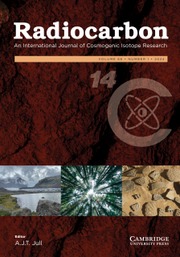No CrossRef data available.
Article contents
RADIOCARBON MORTAR DATING INTERCOMPARISON MODIS2—APPROACH FROM THE ZAGREB RADIOCARBON LABORATORY, CROATIA
Published online by Cambridge University Press: 30 September 2024
Abstract
The Second International Mortar Dating Intercomparison Study (MODIS2) took place in 2020. Three mortar samples from different sites and chronologies were distributed among various research groups in form of bulk mortar and grain fraction smaller than 150 µm. This is the first time the Zagreb Radiocarbon Laboratory, with support of the Center of Applied Isotope Studies, University of Georgia, took part in the international mortar intercomparison. The initial approach of the Laboratory to mortar dating was to separate 32–63 µm grain fraction and collect three CO2 gas portions by sequential dissolution with acid. After checking the 14C date trends of the gas portions, which should be ascending with later fractions, the one for the first and shortest gas portion was reported as the age of the mortar. However, the first gas portion might not be true age of the mortar, since it still might contain some “dead” carbon. Therefore, data extrapolation from the first two initial CO2 portions was also conducted on the results, but not reported to the intercomparison. Though in general, all the intercomparison reported dates fit the expected historical ages, for one sample, the extrapolated result showed a better match to the historical data.
Keywords
- Type
- Conference Paper
- Information
- Radiocarbon , Volume 66 , Issue 5: 24th Radiocarbon and 10th 14C & Archaeology, Zurich, Sept. 11–16, 2022 Proceedings Part 1 of 2 , October 2024 , pp. 1354 - 1367
- Copyright
- © The Author(s), 2024. Published by Cambridge University Press on behalf of University of Arizona
Footnotes
Selected Papers from the 24th Radiocarbon and 10th Radiocarbon & Archaeology International Conferences, Zurich, Switzerland, 11–16 Sept. 2022



